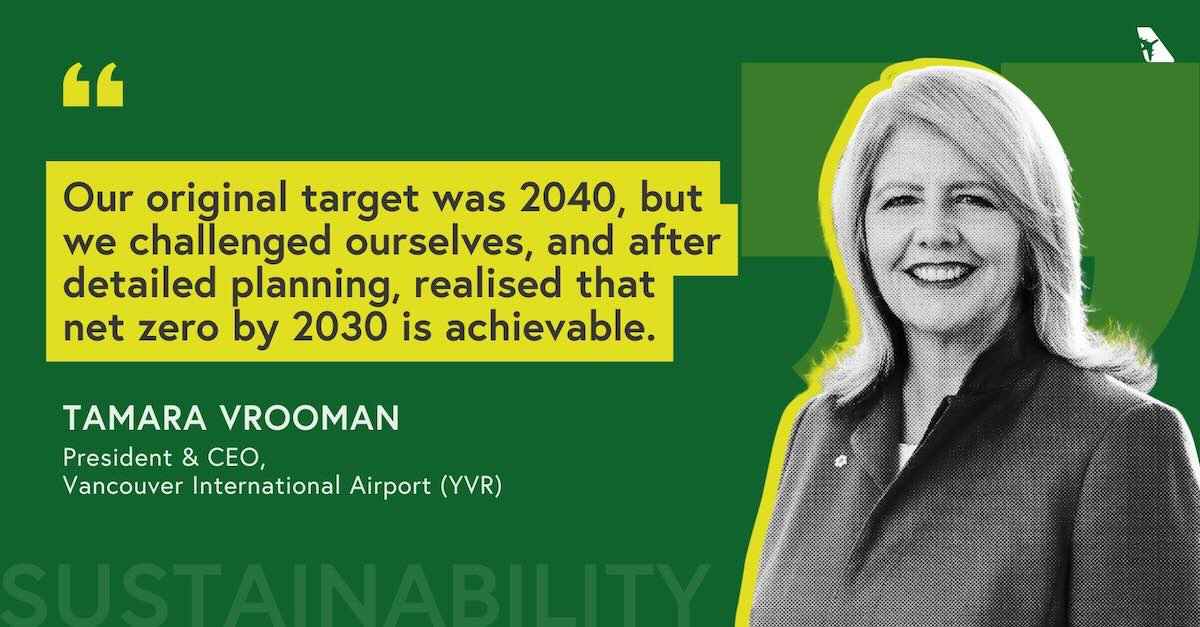In this episode of our ‘Sustainability in the Air’ podcast, Tamara Vrooman, President and CEO of Vancouver International Airport (YVR), speaks with SimpliFlying’s CEO Shashank Nigam about the airport’s ambitious commitment to achieve net-zero operations by 2030.
YVR has developed a detailed net-zero roadmap built on four pathways: capital improvements, conservation initiatives, sustainable fuels adoption, and comprehensive data monitoring. The airport is implementing Canada’s largest geo-exchange system, partnering with airlines and the provincial government to build British Columbia’s sustainable aviation fuel (SAF) ecosystem, and leading a regional collaboration that aims to make BC the world’s first net-zero aviation region.
Here are the key highlights of the conversation:
Why 2030 matters for greenhouse gas reduction (0:33)
Four pathways to net-zero operations (7:24)
The airport’s leverage as an energy hub (13:19)
Building BC’s sustainable aviation fuel ecosystem (21:36)
Regional collaboration across British Columbia (16:22)
Government policy lessons from carbon tax experience (36:18)
Hydrogen’s role in the long-term vision (44:00)
Rapid Fire! (46:46)
Keep reading for a detailed overview of the episode.
Why airports must lead the energy transition
Vancouver International Airport sits on a flood plain, on an island in a large river delta, next to the ocean on Canada’s west coast. For Vrooman, climate change isn’t an abstract future concern; it’s a daily operational reality. “We’re facing droughts, atmospheric rivers, cyclones, and other extreme weather events that we’ve never experienced before in our lifetime,” she says.
This vulnerability drives urgency but also opportunity. Aviation is, as Vrooman acknowledges, “a fossil fuel industry.” Yet it remains essential to global connectivity, trade, and the survival of communities, particularly in a country as geographically vast as Canada. The challenge is to balance this necessity with environmental responsibility.
Vrooman believes airports hold a distinctive position within the aviation ecosystem. Unlike individual airlines running their own sustainability projects, airports can deliver shared infrastructure that drives system-wide change. “When we provide electrification centrally to the entire airport, everyone benefits,” she explains. “An airline switching to sustainable fuels or a tenant adopting hydrogen creates positive change, but it doesn’t have the same scale of impact as when the airport provides it for all users.”
This potential to shape the energy landscape is why YVR has redefined itself as an energy hub rather than just a transportation gateway.
Four takeaways from the conversation
1. Accelerating timelines through detailed planning
YVR’s net-zero journey started with a 2040 target. Later, that timeline was brought forward to 2030.
The ten-year acceleration wasn’t driven by optimism or pressure, but by careful planning. Vrooman explains that the airport approached decarbonisation the same way it would any major capital project.
“We just went through the methodical planning work that we do when we extend a runway or build a terminal. We found that 2030 was achievable and that the investment was manageable over a decade.” The key was treating decarbonisation with the same rigour as any major infrastructure project.
This roadmap breaks the long-term goal into measurable steps. “You have to break it down into component parts to be able to measure progress and make changes along the way,” Vrooman says. Tracking progress in smaller, manageable chunks helps the airport course-correct early rather than discovering issues too late.
2. Leveraging data-driven certification for accountability and collaboration
YVR is one of only three airports in North America to achieve the ACI Airport Carbon Accreditation of Level 4+, a distinction Vrooman values not for prestige but for practical reasons. “It’s a very data-driven accreditation,” she emphasises. “It requires us to validate data we collect and gives us greater confidence that we’re measuring the right things in the right way, at the right time, on our path to net zero.”
The certification also supports collaboration across the region. YVR has signed a memorandum of understanding with all other airports in British Columbia, sharing best practices, measurement methods, and procurement benefits.
“We’re the largest airport by quite a margin,” Vrooman explains. “So if we’re buying two things, why not buy an extra one for a smaller airport, letting them benefit from scale as they pursue their sustainability journey?”
This regional approach could make British Columbia a global first. “We believe we could be the first region in the world to have all of its airports reach net zero,” Vrooman says.
Beyond collaboration, the certification also informs operational decisions. Its data-driven framework allows YVR to track return on investment and ensure projects deliver the greenhouse gas reductions they promise. “Because [the ACI certification] is so data-driven, it helps us create value in how we allocate capital and ensure we achieve the right return.”
3. Building sustainable aviation fuel supply chains from scratch
For YVR, the challenge with SAF is about supply, not demand. “I don’t see a real problem with demand,” Vrooman says. “Air Canada, our largest domestic carrier, has commitments in that regard. The issue is that SAF isn’t readily available in Canada. When they fly to Europe, they refuel with SAF, but they can’t do that here.”
British Columbia has the potential to produce SAF domestically. Its forestry and agricultural industries could supply wood waste and agricultural oils as feedstocks, while refining capacity exists in nearby Alberta and southern BC. Vancouver, Calgary, and Edmonton form a connected aviation network through existing fuel pipelines. “It seems like it would be a natural market,” Vrooman notes.
Yet the ecosystem remains disconnected. “We’re in the classic phase where the supply chain isn’t efficient, whether it’s sourcing sustainable feedstock, refining and production, or transport,” she adds.
YVR seeks to tackle these gaps through partnerships rather than direct procurement. The airport works with Air Canada and the provincial government to develop production capacity and establish a low carbon fuel standard. YVR also administers British Columbia’s low carbon fuel credit system, providing fuel credits to airlines using SAF.
“In that way, we help create the marketplace,” Vrooman says. Last year, this system supported the purchase of nearly 77 million litres of SAF, she shares.
Vrooman is cautious about airports buying large volumes of SAF directly as a short-term fix. “If we just buy SAF, it gets used, then we don’t have any for six months, then we buy more. I don’t see how that solves the problem,” she says. In Vrooman’s opinion, such approaches don’t address the fundamental supply problem or create lasting infrastructure. Instead, YVR focuses on building long-term, sustainable infrastructure that ensures a steady SAF supply for the future.
4. Learning from carbon tax implementation
Vrooman’s experience designing British Columbia’s carbon tax offers lessons for effective environmental policy. As Deputy Finance Minister, she helped create North America’s first carbon tax, which was initially revenue-neutral, with proceeds reinvested into infrastructure and technology.
“There was wisdom in that reinvestment,” she reflects, “because it funded the infrastructure and changes that were needed on the ground.” But over time, many carbon taxes were repealed. “They ended up just being a tax, like any other tax. They didn’t deliver the transformational market change they were designed to achieve,” she explains.
This lesson informs YVR’s current approach to sustainability: penalties alone don’t create markets when supply doesn’t exist. “The problem isn’t a lack of demand or willingness from industry or individuals,” Vrooman says. “It’s that there’s no supply at a competitive rate. Without supply, these measures just become a deadweight cost for households, businesses, airlines, and the broader transportation ecosystem.”
Effective policy, she argues, needs both sticks and carrots, but crucially, it must create the conditions for supply to emerge. “We have to do our part to make the supply part of that equation realistic. Then, of course, there should be penalties for those who are laggards. From what I’ve seen, and from past experience, there will be a shift if supply is consistent.”
This philosophy explains why YVR prioritises building the ecosystem over relying on compliance mechanisms or offsets. Infrastructure must exist before incentives or penalties can drive meaningful change.
Get our new book
Our new book Sustainability in the Air: Volume Two is now available for purchase on Amazon. Learn more about the startups, strategists, and sceptics working to close the gap between growth and green ambition.
‘Sustainability in the Air’ is the world’s leading podcast dedicated to sustainable aviation. Through in-depth conversations with top aviation leaders, we break through the clutter and provide a clear roadmap for a net-zero future.












